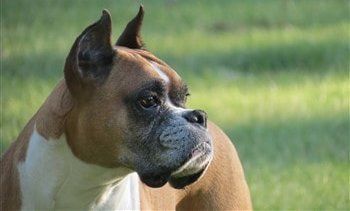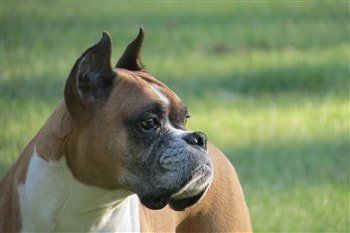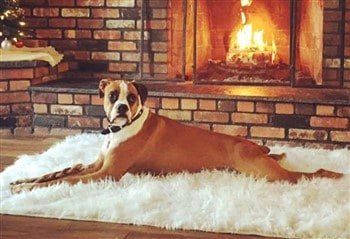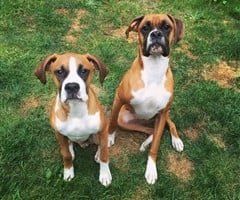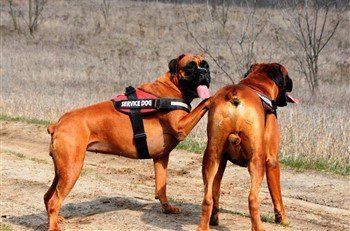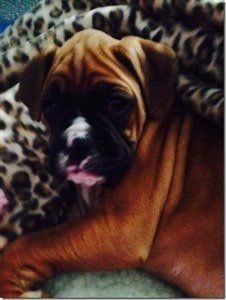Boxer Dog Appearance
Overview
The Boxer dog is part of the Molosser/Mastiff family. These dogs can be broadly categorized by having a heavy bone set, naturally hanging pendent ears, a rather short and well-muscled neck, and a short broad muzzle. The compact muzzle places the Boxer in the Brachycephalic group, though to a lesser degree than other short-nosed breeds.
The tail is naturally long, with only about half of Boxers in the U.S. being docked to create a short, erect tail. The ears are naturally pendant, of moderate size, with very few in the United States being cropped to create shorter, erect ears.
He is considered a medium to large breed in the Working Dogs category, with a short, tightly-packed coat. Puppies have a roundish, soft appearance and adults are well-muscled.
Expected Appearance Per Breed Standards
The breed standard serves two main purposes; it is a guideline for breeders in their efforts to produce dogs that fit close to the ideal to work towards the 'betterment of the breed' and it is used as a guideline for judges when evaluating dogs in the show ring.
So, to first understand Boxer dog appearance, let's take a quick look at some excerpts from both the AKC and FCI Boxer dog standards:
AKC:
The ideal Boxer is a medium -sized, square - built dog of good substance with short back, strong limbs, and short, tight-fitting coat. His well - developed muscles are clean, hard, and appear smooth under taut skin... His expression is alert... The chiseled head imparts to the Boxer a unique individual stamp. It must be in correct proportion to the body.
The broad, blunt muzzle is the distinctive feature, and great value is placed upon its being of proper form and balance with the skull....Substance – Sturdy, with balanced musculature. Males larger boned than females.
FCI: The Boxer is a medium sized, smooth coated, sturdy dog of compact, square build and strong bone. His muscles are taut, strongly developed and moulded in appearance... The Boxer must be neither cumbersome nor heavy, nor light or lacking in body substance.
You may be wondering what the 'square build' is, that both the AKC and FCI refer to.
This means the muzzle is 1/3 the length of the entire head (from the tip of the nose to the back of the skull). and the muzzle is also 2/3 the width of the skull. In addition, the measurement from the top of the withers (shoulder blades) to the floor is about equal as from the middle of the chest to the rear of the upper thigh.
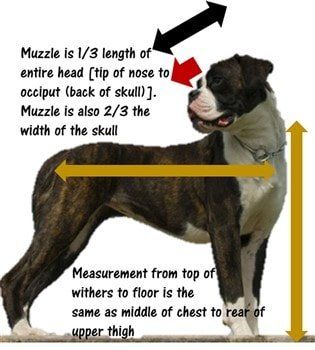
Size
Though there are guidelines in regard to how tall a Boxer 'should' be and what his adult weight 'should' be, many Boxers do fall below or above this.
In regard to height, per AKC standards, males are to be 23-25 inches (58.42-63.5 cm) - this is measured from the floor to the withers and females are to be 21.5-23.5 inches (54.6-59.7 cm).
In regard to weight, the AKC does not list any certain weight. However, most adult male Boxers will fall in the 60-70 pound range and females will be slightly smaller, often between 55-65 pounds. This said, there are lots of Boxers that are considerably larger, 80, 90 and even 100+ pounds, like Marci, one of the Boxer dogs profiled in the IPO protection training
page.
You do
need to keep an eye out to make sure that a Boxer is at a healthy weight as being overweight
brings along quite a few health issues; however, most large Boxer dogs simply have large bone structure.
Modifications - Ears
The US is one of the few countries in which ear cropping is legal; and in show, ears may be cropped or natural. Even though it is allowed in the states, most breeders/owners do not opt to have this done. More often than not, those who believe that a Boxer may do well in the show ring lean towards cropping the ears (many judges do prefer this, independent of the standard's non-bias verbiage). Judging from the photos that we receive, we'd say that about 90% of our readers have Boxers with natural ears and about 10% have cropped.
Axel,Photo courtesy of Sarah Martin
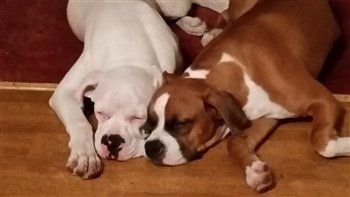
Ash & Cinder, 7 months old brothers
Photo courtesy of Jamie McEvers
Below is a great photo showing 3 Boxer dogs in the same household and in fact, what you're seeing is Nayla (the mother, with natural ears), Oscar (the father, with cropped ears) and Rocky (the son, with natural ears). Photo courtesy of Terry Faircloth
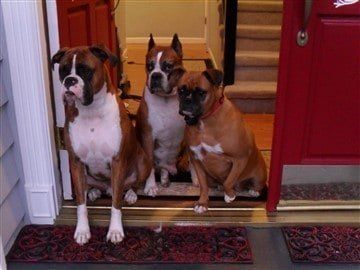
Modifications - Tail
Similar to ear cropping, tail docking
is illegal in many countries; however, the United States does allow this and it is actually expected in the show ring. Since this is done within just days of a Boxer pup being born, it is the breeder who decides on this. Many will go by what they know puppy buyers prefer and most (if they do not oppose docking) will ask the intended owners in advance, if someone has a deposit on a pup.
In regard to the many photos of Boxers that we receive from Members, we'd estimate that about 60% of Boxers have natural tails and 40% are docked. What we see more often than not, is that with a docked tail, the ears are rarely cropped. So, it is uncommon, at least in the U.S., to see a Boxer with both
modifications.
Jaxx, at 2 years old | Photo courtesy of Kimberly Marciano
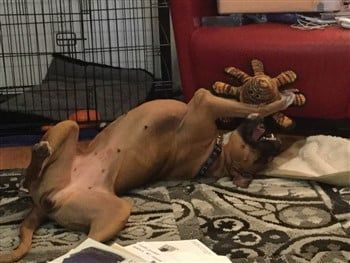
Ginger, at 2 years old | Photo courtesy of Patricia English
Body Shape Changes
Young Boxer puppies are naturally a bit round, but they grow very quickly. Once a Boxer is close to the 1 year mark and up to the 2 year mark, he can sometimes be growing so fast in height, that he can't keep up in weight. We refer to this as the Boxer dog skinny
phase and it typically only lasts a short while.
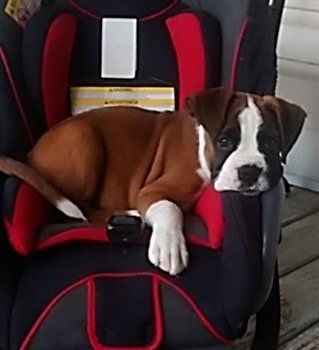
Young Boxer pups are just power-houses waiting to mature. They are rounded and muscles are not yet fully developed. Just look at how big this pup's paws are; he'll be at full adult size by about the 2 year mark.
Atticus, at 9 weeks old
Photo courtesy of Anthony Klintworth
Nearing the 1 year mark, Boxers have grown exponentially in height. They are, of course, gaining weight as well. This is a transitional phase before full adult form takes place.
Wilson (at 7 months) and Bruce (at 1 year)
Photo courtesy of Salina Harmon
As adults, Boxers will look lean yet strong. As the Boxer matures, his chest fills out, widening and really becoming a focal point. Flanks are lean and legs are relatively long, which gives him a great profile.
Due to the short, packed coat, muscles are often quite visible, which lends to a sleek, strong appearance. Boxers were used extensively in WWII but both American forces and the British army; not only can they look intimidating, they do very well in regard to training for guard, security, surveillance and as messengers. Today's Boxer is a family dog, yet good breeding gives us super confident looking dogs that are great watchdogs, not only just by their appearance, but also loyalty to protect their family.
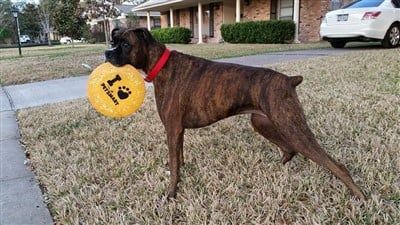
Stella, at 5 years old | Photo courtesy of Kendall Foy
Coloring
There are only 3 basic colors
for the Boxer dog: Fawn, brindle and white. Fawn and brindle are standard and white is an alternate color. Though white is not accepted in the show right, white Boxers
can, of course, be registered. About 25% of Boxers are born white and of those 25%, 25% of them have hearing loss or are deaf. Of these, the majority are unilaterally deaf (one ear), as opposed to bilaterally (both ears).
In regard to fawn and brindle, this does not mean that all Boxers look alike; far from it! Color is, perhaps, the one feature that causes Boxers to have such varied appearances. Fawn can range from a very light tan to a reddish fawn. And brindle (which is a pattern of striping) can range from light to super dark. In fact, some very heavy brindled Boxer dogs may appear to be a solid dark color. A few even may appear to be black, though this is genetically impossible.
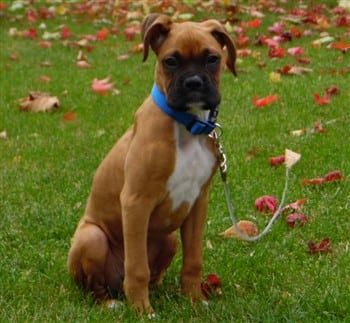
A beautiful fawn Boxer
Lucky, at 13 weeks
Photo courtesy of The Colon Family
Some Boxer dogs can be a nice, deep, shiny fawn / red
(these are European Boxers)
Marci and Eszmeralda
Photo courtesy of Karoly Tihanyi
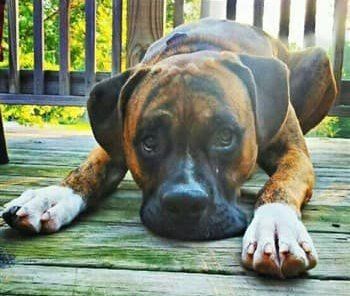
This Boxer is a light to medium brindle
Buster, at 4 years old
Photo courtesy of Nicole Feig
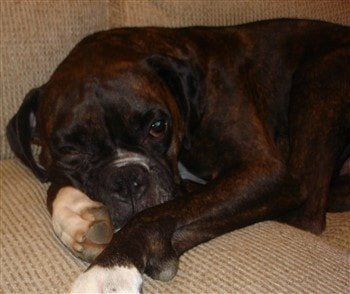
And this Boxer is a rich, dark brindle
Turkish, at 7 years old
Photo courtesy of Renata
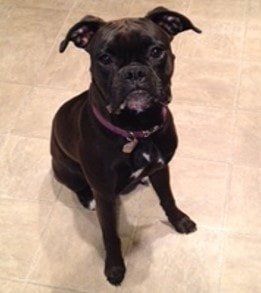
Some Boxers are so heavily brindled, that they appear to have a solid dark coat
Keiko, at 4 months
Photo courtesy of Brigitte McDonald
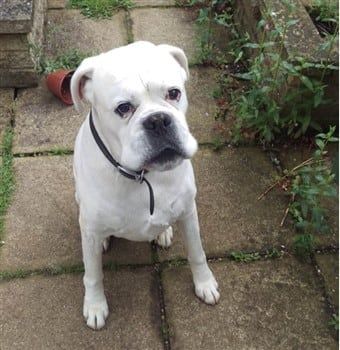
And about 25% of Boxers are white (with or without patches)
Ollie, at 12 years, 3 months
Photo courtesy of Lorraine Johns
White Markings
Many Boxers have white markings. This often appears on the chest. It may also be on the legs (anywhere from just the paws - referred to as mittens - to almost the entire leg. Per the AKC, white should not exceed 1/3 of the coat.
If a Boxer has more than 1/3 white on him, this is referred to as 'flashy'. And if he is almost all white with just a bit of fawn or brindle, he is 'extra flashy'.

Just a bit of white
Titus, at 10 months
Photo courtesy of Ash & Ronnie
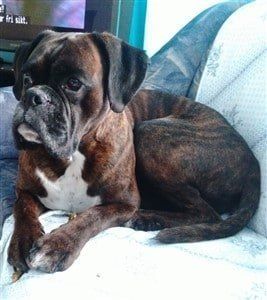
A small to moderate
patch of white
Samson
Photo courtesy of Tom Eirik Bang
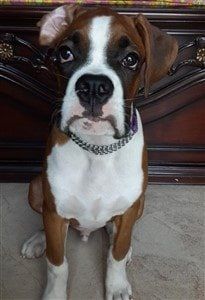
An just about at 1/3 (prob. a bit under)
Marc, at 22 weeks old
Photo courtesy of Sunil Dutt
White on the Face
White can also appear on a Boxer dog's face. If there, it may be symmetrical or non-symmetrical. In show, it is preferred that it be symmetrical; though, there is no preference as to whether or not it runs between the eyes and onto the forehead (known as a blaze).
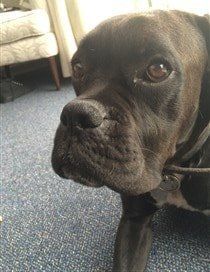
Reverse brindle; no mask
King
Photo courtesy of Kerry de Viet
Black mask with white markings on it
Bella, at 8 weeks old
Photo courtesy of Lyndell Dillon
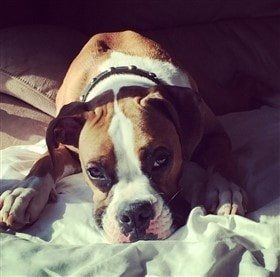
White mask,
with the additional white blaze
Jaxx, at 1 year old
Kimberly Marciano , N.Y
Senior Appearance
Unfortunately, Boxers do not have exceptionally long life spans; many pass by the 12-year mark. However, this is not to say that Boxers can't live well into their teens; many do. In fact, the oldest living Boxer dog on record
here is 15, going on 16. Other Boxers have lived even longer (seen in the memoriam).
As Boxers age, there are changes in appearance. Most notably, there is a loss of muscle tone. This happens very gradually and is due, in part, to an older dog not having as much mobility as his younger counterpart. The other element that often changes is that there is a graying around the muzzle. This is very common once a Boxer reaches 13 or 14 years old.

You'll notice thinner bodies with senior Boxers
in their teens often a graying on the muzzle that may extend upward around the eyes and over the forehead |
CeCe, at 16 years old, Photo courtesy of Sophy Korm
Bite
Boxers have a slight to moderate undershot bite, which means that the lower jaw protrudes out further than the upper. Due to the loose lips of the Boxer, the bite is not easily discernible when a Boxer has his mouth closed. However, you can usually tell by looking at the lips; if the lower lip protrudes past the upper lip, this is a sign that the bite is too undershot. Boxers of Kellaney has a great PDF called Explaining the Boxer Bite, that explains this in full, with helpful photos.
Boxer Dog Expressions
To finish, let's touch a bit on the comical side and take a look at different expressions, since this can
be considered part of a Boxer's appearance. And beside the fact, these sorts of photos are too awesome to pass up!
Boxers are incredibly talented for making just the right expression to tell you exactly what they're thinking and feeling. Let's take a look at some of the crazy, silly, pleading and sometimes super serious expressions that a Boxer dog can have.
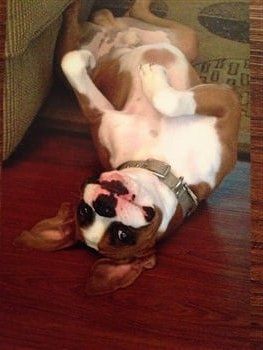
Boxers are great at looking goofy...
Jasper, at 2 years, 10 months
Photo courtesy of Carrie
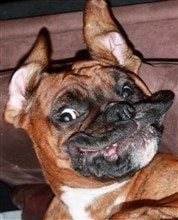
They've definitely mastered the technique...
Missy, at 11 months old
Photo courtesy of Gail Rivers
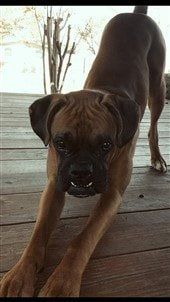
But try to leave the house, and you may get this expression....
Rosco Tiberius, at 3 years, 3 months
Photo courtesy of Janean Workman
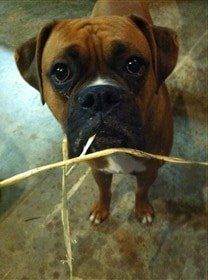
Boxers are incredibly apt in looking innocent,
no matter what...
Booger, at 1.5 years old | Photo courtesy of Dylan Fairfield

And they can hold a stare, pleading with their eyes until you break down and give in...
Mazzy and Bruno
Photo courtesy of Jessi Ann Goodwin
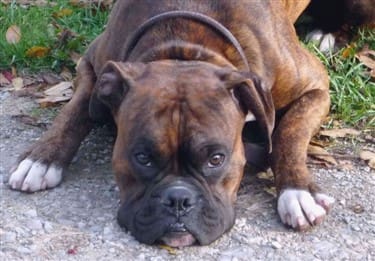
Most of all, you never really need to wonder what a Boxer dog's thinking. Through body stance and facial expression,
they make it quite clear.
Braunson, Photo courtesy of Marianne Yates
You may also like:
How much water a Boxer dog needs
- Making sure that your Boxer is hydrated is super important to his overall health. See how much puppies and adults require.
When a Boxer dog has gas
- Some flatulence is normal; however, it's important to know what is considered excessive, reasons why this happens and at-home remedies.
Which shampoo is best for a Boxer dog
- The best products to keep the skin from getting too dry and to help keep the coat healthy and shiny. Covers both regular shampoo and those for certain skin issues.
Boxer dog eye discharge
- Often eloquently referred to as 'eye booger's; read about why these develop and how to properly clean them to prevent eye irritation with your Boxer puppy or adult dog.
Boxer dog is drooling
- How much is normal and reasons why it may be excessive.

